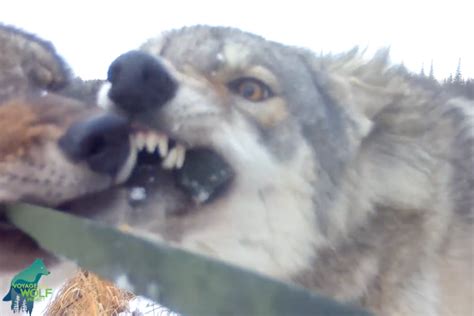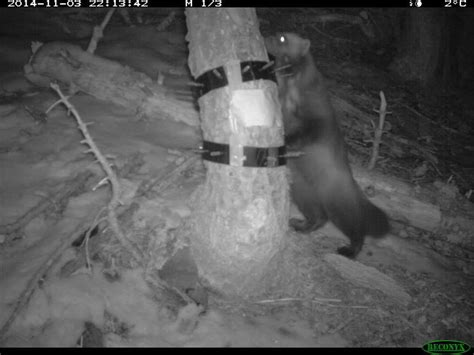
A lone gray wolf has been documented significantly south of its established range in Wisconsin, captured on trail cameras in Iowa County, sparking excitement and raising questions about wolf dispersal and potential expansion into new territories. The Wisconsin Department of Natural Resources (DNR) confirmed the sighting, marking a rare occurrence in an area where wolf presence is not typically observed.
The trail camera footage, obtained by a private landowner and subsequently shared with the DNR, shows a single wolf traveling through a wooded area in Iowa County. This sighting is notable because the primary wolf population in Wisconsin is concentrated in the northern and central parts of the state. Wolves occasionally venture into southern Wisconsin, but these instances are relatively infrequent and usually involve transient individuals.
“This sighting is a good reminder that wolves can travel great distances, and people should be aware of their presence,” said DNR spokesperson Sarah Hoyle. The DNR is continuing to monitor wolf activity across the state and encourages the public to report any sightings or observations.
The appearance of a wolf in Iowa County prompts several important considerations. It highlights the species’ capacity for dispersal and its potential to colonize new areas, raising questions about habitat suitability, prey availability, and potential interactions with humans and livestock in southern Wisconsin. The DNR will likely use this data to refine their understanding of wolf behavior and distribution patterns and adjust management strategies accordingly.
Wolf Dispersal and Range Expansion
Gray wolves are known for their ability to travel long distances in search of food, mates, or new territories. Young wolves, in particular, often disperse from their natal packs as they reach maturity, seeking to establish their own territories and form new packs. This dispersal process is essential for maintaining genetic diversity and allowing wolves to adapt to changing environmental conditions.
In Wisconsin, wolf dispersal has been a key factor in the species’ recovery since being placed on the endangered species list. After near extirpation in the mid-20th century, wolves began to return to the state in the 1970s and 1980s, primarily through natural dispersal from neighboring states like Minnesota and Michigan. The wolf population has steadily grown since then, leading to the eventual delisting of the species from federal protection.
The sighting in Iowa County suggests that dispersal continues to play a role in wolf dynamics in Wisconsin. While the individual captured on trail camera may simply be a transient wolf passing through the area, it also raises the possibility that wolves could eventually establish a more permanent presence in southern Wisconsin.
Habitat Suitability and Prey Availability
The suitability of southern Wisconsin as wolf habitat depends on several factors, including the availability of suitable prey, the presence of adequate cover, and the level of human disturbance. Wolves primarily prey on deer, but they will also consume smaller mammals, birds, and even insects.
Southern Wisconsin has a high deer population, which could potentially support a wolf population. However, the area is also more heavily populated by humans and has less contiguous forest cover than northern Wisconsin. This could limit the availability of suitable habitat and increase the risk of conflicts between wolves and humans.
The DNR is currently assessing the habitat suitability of southern Wisconsin for wolves. This assessment will take into account factors such as prey density, forest cover, road density, and human population density. The results of this assessment will help the DNR to make informed decisions about wolf management in the region.
Potential Conflicts with Humans and Livestock
As wolves expand their range into more populated areas, there is an increased risk of conflicts with humans and livestock. Wolves may prey on livestock, particularly cattle and sheep, and they may also be perceived as a threat to human safety.
The DNR has a program in place to compensate farmers for livestock losses caused by wolves. The program provides financial assistance to farmers who implement preventative measures to protect their livestock, such as fencing and guard animals.
The DNR also works to educate the public about wolf behavior and how to avoid conflicts with wolves. This includes providing information on how to properly secure livestock, avoid attracting wolves to residential areas, and respond appropriately if a wolf is encountered.
“It is important for people to be aware of the possibility of wolves in their area and to take steps to minimize the risk of conflicts,” Hoyle stated. “By working together, we can help ensure that wolves and humans can coexist peacefully in Wisconsin.”
Management Strategies and Ongoing Monitoring
The DNR employs a variety of management strategies to ensure the long-term health and sustainability of the wolf population in Wisconsin. These strategies include:
- Population monitoring: The DNR conducts annual surveys to estimate the size and distribution of the wolf population. These surveys involve tracking wolves using radio collars, monitoring wolf pack activity, and collecting data on wolf mortality.
- Habitat management: The DNR works to maintain and improve wolf habitat by managing forests, controlling invasive species, and protecting important denning and rendezvous sites.
- Conflict management: The DNR investigates reports of wolf conflicts with humans and livestock and takes appropriate action to resolve these conflicts. This may include providing technical assistance to landowners, implementing preventative measures, or, in rare cases, removing problem wolves.
- Public education: The DNR provides information to the public about wolf behavior, wolf management, and how to avoid conflicts with wolves. This information is disseminated through websites, publications, presentations, and outreach events.
The DNR is committed to managing the wolf population in Wisconsin in a responsible and sustainable manner. The sighting in Iowa County underscores the importance of ongoing monitoring and adaptive management to ensure that wolves can continue to thrive in the state.
The Importance of Trail Cameras
The wolf sighting in Iowa County highlights the increasing importance of trail cameras in wildlife monitoring and research. Trail cameras are remotely triggered cameras that can be deployed in the field to capture images and videos of animals. They are a valuable tool for studying wildlife behavior, distribution, and abundance.
Trail cameras are particularly useful for monitoring elusive species like wolves, which can be difficult to observe directly. The cameras can be placed in areas where wolves are likely to travel, such as along trails, near water sources, or in areas with dense forest cover. When an animal triggers the camera, it automatically captures an image or video, providing valuable data on the animal’s presence and behavior.
The use of trail cameras has revolutionized wildlife research in recent years. They have allowed scientists to collect vast amounts of data on a wide range of species, providing new insights into animal ecology and behavior. The data collected from trail cameras can be used to inform conservation and management decisions, helping to protect wildlife populations and their habitats.
In the case of the Iowa County wolf sighting, the trail camera footage provided irrefutable evidence of the animal’s presence in the area. This information is valuable to the DNR as it assesses the potential for wolf expansion into southern Wisconsin.
Legal and Political Context
The management of gray wolves in Wisconsin has been a subject of ongoing legal and political debate. The species has been listed and delisted from the federal endangered species list multiple times, reflecting differing views on the appropriate level of protection for wolves.
When wolves are listed under the Endangered Species Act, they are afforded federal protection, which limits the ability of states to manage wolf populations. When wolves are delisted, states have more flexibility to manage wolves according to their own management plans.
In recent years, there has been considerable controversy surrounding wolf management in Wisconsin. Following a court decision delisting wolves from federal protection, Wisconsin held a wolf hunting season in February 2021. This season was met with criticism from conservation groups and tribal nations, who argued that it was conducted prematurely and without adequate scientific basis.
The legal and political landscape surrounding wolf management in Wisconsin is complex and constantly evolving. The DNR is committed to working with all stakeholders to develop and implement management strategies that are both scientifically sound and socially acceptable.
The sighting of a lone wolf in Iowa County adds another layer of complexity to this ongoing debate. As wolves potentially expand their range into new areas, it will be important to carefully consider the potential impacts on human communities and to develop management strategies that address the concerns of all stakeholders.
Public Reaction and Community Engagement
The sighting of a wolf in Iowa County has generated considerable public interest and discussion. Some residents are excited by the prospect of wolves returning to southern Wisconsin, while others have expressed concerns about potential conflicts with livestock and human safety.
The DNR is working to engage with local communities and address their concerns about wolves. This includes providing information about wolf behavior, wolf management, and how to avoid conflicts with wolves. The DNR also encourages residents to report any wolf sightings or observations to the agency.
Community engagement is essential for successful wolf management. By working together, the DNR and local communities can develop management strategies that are both effective and acceptable to all stakeholders.
Broader Ecological Implications
The presence of wolves in an ecosystem can have significant ecological implications. Wolves are apex predators, meaning they are at the top of the food chain. Their presence can influence the behavior and distribution of other species, leading to cascading effects throughout the ecosystem.
For example, wolves can help to control deer populations, which can prevent overgrazing and promote forest regeneration. Wolves can also help to improve the health of deer herds by preying on sick or weak individuals.
In addition, wolves can create carrion, which provides food for a variety of other species, including scavengers like eagles, ravens, and foxes.
The reintroduction of wolves to Yellowstone National Park in the 1990s provides a well-documented example of the ecological effects of wolves. The reintroduction of wolves led to a decrease in the elk population, which in turn allowed vegetation to recover along rivers and streams. This led to increased biodiversity and improved habitat for a variety of other species.
While the ecological effects of a single wolf in Iowa County are likely to be limited, the potential for wolves to expand their range into southern Wisconsin could have significant ecological implications in the long term.
Future Research and Monitoring
The DNR is planning to conduct further research and monitoring to better understand wolf activity in southern Wisconsin. This may include deploying additional trail cameras, conducting track surveys, and collecting scat samples for DNA analysis.
The data collected from these studies will help the DNR to assess the potential for wolf expansion into southern Wisconsin and to develop appropriate management strategies.
The DNR is also collaborating with researchers from universities and other organizations to study wolf behavior, ecology, and genetics. This research will provide valuable insights into the factors that influence wolf distribution and abundance and will help to inform wolf management decisions.
The wolf sighting in Iowa County is a reminder that wolves are a dynamic and adaptable species. As they continue to recover and expand their range, it will be important to continue to monitor their populations and to adapt management strategies accordingly.
Conclusion
The documented presence of a lone wolf in Iowa County, Wisconsin, far south of its established range, underscores the species’ remarkable capacity for dispersal and raises important questions about its potential to colonize new areas. This event highlights the ongoing dynamics of wolf populations in the state and the need for continued monitoring, research, and adaptive management strategies. While the long-term implications of this sighting remain to be seen, it serves as a reminder of the complex interplay between wildlife, habitat, and human communities, emphasizing the importance of informed decision-making and proactive conservation efforts to ensure the coexistence of wolves and humans in Wisconsin. The DNR’s commitment to public education, conflict mitigation, and collaborative engagement with local communities will be crucial in navigating the challenges and opportunities presented by the potential expansion of wolf populations in the state. The use of trail cameras and other advanced monitoring techniques will continue to play a vital role in tracking wolf movements and understanding their ecological impact, contributing to a more comprehensive and science-based approach to wolf management in Wisconsin.
Frequently Asked Questions (FAQ)
-
Why is the sighting of a wolf in Iowa County significant?
The sighting is significant because Iowa County is located in southern Wisconsin, which is outside the primary established range of wolves in the northern and central parts of the state. It suggests that wolves may be dispersing and potentially expanding into new territories. “This sighting is a good reminder that wolves can travel great distances, and people should be aware of their presence,” said DNR spokesperson Sarah Hoyle.
-
What is the Wisconsin DNR doing in response to this sighting?
The Wisconsin DNR is monitoring wolf activity across the state and encourages the public to report any sightings or observations. They are also likely assessing the habitat suitability of southern Wisconsin for wolves, considering factors like prey availability, forest cover, and human disturbance.
-
What are the potential risks associated with wolves expanding into southern Wisconsin?
Potential risks include conflicts with humans and livestock. Wolves may prey on livestock, particularly cattle and sheep, and some people may perceive them as a threat to human safety. The DNR has a program to compensate farmers for livestock losses caused by wolves and provides education on how to avoid conflicts.
-
How does the DNR manage the wolf population in Wisconsin?
The DNR employs various management strategies, including population monitoring (using radio collars and tracking pack activity), habitat management (maintaining and improving wolf habitat), conflict management (investigating reports of conflicts and implementing preventative measures), and public education (providing information about wolf behavior and management).
-
What should I do if I encounter a wolf in Wisconsin?
If you encounter a wolf, it’s important to remain calm. Do not run. Make yourself look large by raising your arms and waving them slowly. If you are with others, gather together. Speak in a loud, firm voice. If the wolf approaches, throw something towards it. Back away slowly, maintaining eye contact. Report the sighting to the Wisconsin DNR.









